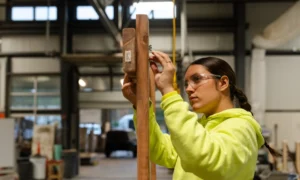Lebanon, Pa.
Alan McLoughlin spends much of his week laboring in his family’s construction business, doing what’s commonly considered tiring work. He spends about 30 hours a week at another job: eating pizza and talking with kids from the juvenile justice and child welfare systems, joining them on community service projects and helping them with school.
He says the second job can wear him out.
 “It’s not for everybody,” says the 29-year-old, one of nine “advocates” employed by the Youth Advocate Programs (YAP) in Lebanon County. “You can get worn down by some clients.”
“It’s not for everybody,” says the 29-year-old, one of nine “advocates” employed by the Youth Advocate Programs (YAP) in Lebanon County. “You can get worn down by some clients.”
Adds Melissa Snyder, who does the same job fulltime at YAP: “I don’t think all the advocates know what they’re getting into.”
But a lot of them think they do, because every week YAP’s national office sends paychecks to 1,600 such advocates – including 1,100 part-timers – in eight states. What’s more, YAP offers all of them full health coverage for about $30 a week, and it’s about to add a company-supported retirement plan.
This unusual network of full- and part-time youth workers is a key reason that YAP was able to hold a gala anniversary celebration last month in Harrisburg, Pa., where it was founded 30 years ago. YAP has quietly grown from a one-room office in 1975 to employing 2,300 people on a $65 million budget.
The anniversary party was somewhat dreamy-eyed at times, jammed with believers who are pumped up about their mission to overhaul juvenile justice and child welfare, primarily by keeping kids out of institutions. “We not only want to change outcomes for kids, but we also want to change the system,” says juvenile justice consultant Paul DeMuro, a former chief of youth detention facilities in Pennsylvania and a protégé of YAP’s inspiration: juvenile justice reformer Jerome Miller.
“What you do on behalf of troubled kids is so different [from] what I see nationally, especially when it comes to the heavy lifting these kids need,” Bart Lubow, director of the Program for High-Risk Youth at the Annie E. Casey Foundation, told those gathered for the anniversary.
“What’s unique is they put a number of elements together in a creative way,” said Richard L. Edwards, professor and dean of the Rutgers University School of Social Work. “They’re dealing with the totality of kids, and they take the most difficult kids that no one else will.”
Yet everyone here knows that YAP and other community-based programs still reach only a minority of kids in the systems that YAP wants to change. At any given time, according to the U.S. Justice Department, more than 100,000 juveniles are in residential placement for reasons ranging from violent crime to truancy.
Can YAP persuade more judges, probation agencies and mental health departments to hand “deep-end” kids to community-based agencies?
Some of YAP’s heartiest supporters admit that they’re a long way from sweeping reform. “Until the system is prepared to redeploy resources, programs like YAP will always be on the margins,” Lubow says. “There’s a growing thirst for putting kids in cages – even when juvenile crime is down.”
History
As the story was often retold during the anniversary events, the inspiration for YAP began when Miller – then commissioner of youth services in Massachusetts – closed the state’s reform schools in 1972, sending most of the kids into community-based programs.
The so-called “Massachusetts Experiment” worked well enough to spawn community-based programs there and elsewhere. In 1975, as special assistant to the governor of Pennsylvania, Miller devised strategies to remove 1,000 youth offenders from the state’s adult prisons, including 400 at Camp Hill, near Harrisburg.
When a Harrisburg-area church withdrew from plans to provide community-based services for 100 of the youths because of the perceived danger, a new agency was needed. Tom Jeffers, who had worked with Miller in Massachusetts and Illinois, started
YAP as the new community services provider.
Today, Miller sits on YAP’s board of directors.
Minette Bauer, then a 21-year-old graduate of Pennsylvania State University, was one of YAP’s first hires and was assigned to help reintegrate kids from Camp Hill with their families. Bauer had toured Camp Hill during an open house when she was 15 and had been shocked to see kids her own age behind bars. “So it was very exciting to consider being part of a reform movement,” she says.
“Some were poor kids who had never been in a restaurant and didn’t know how to eat properly,” says Bauer, now one of YAP’s deputy CEOs.
Besides building trusting relationships, advocates linked youths to counseling and to educational and job services.
Soon YAP expanded through Pennsylvania – it’s now in 37 of the state’s 67 counties – and into New Jersey, through the auspices of DeMuro, who was then head of the agency for detention and delinquency services in Essex County, N.J.
YAP now has 118 affiliates, including those in England, Ireland, Guatemala and Sierra Leone.
Services have expanded to include programs for pre- and post-adjudicated youth and youth from child welfare; after-care programs for youth returning from placement; services for autistic children; and independent living and life-skills programs.
YAP maintains a central business office in Harrisburg, where a staff of 87 handles all contracting, billing, payroll and quality assurance matters. “We’ve centralized the non-kid-care operations, so we free up local leaders to focus on quality services to kids,” says CEO Jeff Fleischer.
Fleischer says overhead for the Harrisburg operation runs around 11 to 12 percent of the YAP budget, so that about 88 percent of what YAP spends goes back to the communities that contract with YAP.
Saving money is central to YAP’s pitch to local juvenile justice and child welfare officials. YAP says a month of YAP’s services – including the average of 15 hours a week with an advocate – can save local governments $1,800 to $7,000 per client each month from the cost of residential placement. Clients average about six months in YAP programs.
Also, YAP stresses that most of the money it receives for services is spent in the communities where clients live. “America spends millions in faraway residential treatment that’s costly, and the recidivism rate is high,” Fleischer says. “What if you take these millions and invest it in the community in a way that’s community-based and more cost-effective?”
Recruiting Near Home
So it is no surprise that YAP emphasizes the importance of hiring advocates – its front-line workers – from the areas where they will work. “We use ZIP code-based recruitment,” Fleischer says.
“It’s a safety issue, too,” Bauer adds. “If it’s a rough neighborhood, our advocates know how to negotiate themselves in that community, and they know where the dangers are for the kids, too.”
College students and recent graduates are commonly hired as full- or part-time advocates. Also, YAP recruits people who are active in their communities.
“We get master’s in social work, housewives, carpenters, teachers, firemen and accountants,” Fleischer says. “We get people in recovery and people who were once juvenile offenders. The main ingredient is we have people who want to give back and work with kids and families.”
About one-third of the part-time advocates “are with us forever,” he says. “Another third stay two years or so, and the rest work with one or two kids and move on.”
YAP’s advocates are paid $10 to $16 an hour, depending on the contract with local public agencies.
Monitors from Harrisburg call each family once on month “to gauge their satisfaction,” Fleischer says. Occasionally, the client-advocate match doesn’t work well. Probation officials say YAP quickly catches these cases and makes changes.
The screening process includes criminal background checks. Initial advocate training involves 11 two-hour sessions, and training continues throughout the advocate’s time with YAP.
The advocates’ job: Build relationships. That can be done through stops at fast-food joints, arcades and bowling alleys, trips to malls, museums and other attractions, playing games and sports, and doing family chores like the laundry.
The advocates also link clients with mental health and other services and are trained to recognize when such services are needed.
“We teach communications, skill-building and the basics of crisis intervention,” says clinic psychologist Alex Sutton, YAP’s training director. “It takes heart, unconventional approaches and genuine empathy.”
“It’s been my life,” says Frances Blackwell, a longtime foster parent who estimates that over the past 21 years she’s worked with 60 kids as a YAP advocate in rural Cumberland County, N.J. “Some of my successes were hard heads,” but she recalls troubled kids going to college, or one becoming an electrician and another a minister. “Eventually, they settled down.”
“The kids are not nearly as difficult as they’re made out to be,” Bauer says.
Finding Kids
YAP promises “unconditional care” for its youth, with a “no reject, no eject” policy. In reality, the decisions on which youths go to YAP are in the hands of judges or placement agencies. And if the youths violate the law, courts or probation departments may send them to secure confinement.
What “no reject, no eject” means, Fleischer says, “is that if they’re a tough case that hasn’t worked out elsewhere, we’re not going to reject them for that.”
YAP workers tell kids they won’t give up on them, and they say that promise makes a major difference in YAP’s reception among youth.
From the board of directors and CEO on down, YAP workers insist they want to take on the toughest cases, the “deep end” kids for whom others see detention as the only remedy.
That doesn’t mean YAP wants everyone. “There are some very frightening, truly violent offenders in the system, repeat offenders,” DeMuro notes. “No one in their right mind is talking about zero incarceration.”
Youth are recommended to YAP by members of a local stakeholders’ committee that includes representatives from the prosecutor’s and public defender’s offices, probation departments, youth detention centers and sometimes schools. The committee presents the judges or other decision-makers with service plans for each candidate.
Judges are sometimes reluctant to go along completely. Typical of the struggle is Camden County, N.J. Last year, a stakeholders’ committee recommended 123 youths for YAP services, which could help alleviate the severely overcrowded conditions in the county’s juvenile detention system. The judges assigned only 56 cases to receive the full YAP program. Fifty-three of the clients completed the program with no new criminal charges, although five were charged with parole violations.
Did the judges refer kids who were likely candidates for release into the community anyway, rather than kids who might otherwise be sent into residential placement? Such a take-it-easy approach doesn’t please YAP. At a workshop on the Camden program during the anniversary convention, DeMuro asked if the program was getting the difficult kids it needs to convince authorities there that the YAP approach works.
“I’m concerned that the profile of offenders had been watered down,” he said.
“Absolutely,” agreed YAP Deputy CEO Dana Newson. “That’s where we have the most difficulty – with convincing these judges.”
“We’re involved in a struggle,” DeMuro says later. “If you can reform the back end of the system [the toughest cases], you’ll change the front end as well.”
Measuring success
Evidence that YAP-style services produce better results than residential placement and detention is based largely on studies of the wraparound community-based services approach. Wraparound services usually involve interagency collaborations that produce plans for each client.
A 1999 study of the Wraparound Milwaukee Project found a 60 percent decrease in the use of residential treatment for delinquent youths, a reduction in delinquent acts and an 80 percent decrease in psychiatric inpatient placements. Studies of wraparound services in Vermont, Florida and Baltimore have found positive outcomes, including reduced need for residential placements.
No national figures on recidivism among ex-juvenile offenders appear to exist. That’s largely because state definitions of what constitutes recidivism vary, says Hunter Hurst, senior research assistant at the National Center for Juvenile Justice.
State data appear to show that between 50 and 70 percent of boys commit crimes within a year or two of release from a secure facility.
At YAP, Fleischer says, “Our success rate is 80 percent – they complete the program without being rearrested.
“That means that up to 20 percent of the time they end up back in trouble. We’re not a perfect program. Then it might drop to 75 percent six months out.”
Isolated follow-ups of former YAP clients indicate some positive results. The Travis County (Texas) Juvenile Probation Department found that 85 percent of youth who completed the local YAP in fiscal 2000 were not committed to a Texas Youth Commission facility in the following year, and 65 percent did not re-offend within that year. More than half of the 97 youths in the study had felonies before entering the local YAP.
YAP has expanded its monitoring department in Harrisburg to look more thoroughly at outcomes after clients leave the program. “We’re just starting to do it agency-wide,” Fleischer says.
Some outcomes have been known for a long time. Ralph Belle, 48, was one of the first YAP clients out of the Camp Hill facility in 1975. “I had a wild image at the time,” recalls Belle, who says he landed in juvenile detention for fighting and vandalism. He says YAP “put love and trust in me.”
Belle is YAP’s coordinator of building maintenance in Harrisburg.
He says others he knew in Camp Hill who didn’t enter YAP aren’t doing so well. “Two of them,” he says, “are doing life.”
Contact: YAP (717) 232-7580, www.yapinc.org.
How a Local YAP Helps Kids
From a second-floor office in downtown Lebanon, Pa. (population 24,000), a dozen youth workers help several dozen kids live in their communities instead of in institutions like juvenile detention.
At any given time, the Lebanon County Youth Advocate Programs (YAP) serves between 30 and 50 youths, some of whom have been convicted of such charges as assault, burglary, drug dealing or armed robbery involving knives.
“Before YAP was in the picture, most of these kids would have to be [placed] in a residential facility, or get no services at all,” says Bob Swanson, the YAP director for the county.
Nine of the YAP workers are “advocates” – the front-line workers in the YAP model. Seven of the advocates are part-timers: One works at a family construction company, another is a tree surgeon, and the rest are college students in nearby nursing, social work or psychology programs.
Advocates spend up to 25 hours a week with a client and family, building their trust, helping resolve problems and linking them to services in the community. “It can be the kind of work that actually makes you feel good at the end of the week,” says Program Coordinator Jeff Boehler.
The YAP operates under four contracts with Lebanon County agencies, including the Juvenile Probation and Children and Youth Services departments.
About 30 percent of YAP clients come from the county’s Hispanic population, which stands at 5 percent of the 124,000 residents. None of the YAP workers speaks Spanish; the advocates say that’s not a problem, because many Hispanic families are longstanding Lebanon residents who speak fluent English.
Under one contract, YAP monitors youth who are on “home arrest” and are monitored by electronic ankle bracelets. Youth on probation who violate parole are sometimes placed in this program rather than being locked up.
Under another contract, YAP operates a re-integration program for youth coming back into communities from out-of-home placements. Most are in that program for 30 to 90 days.
Some of the youths are sullen, suspicious and uncommunicative, advocates note. They say the job is rewarding nevertheless, because kids respond well to YAP’s promise of a “no reject, no eject” approach.
“Advocates can get discouraged,” Swanson says. “It can be frustrating.”
“They will be doing so well, and then suddenly do something with their friends that gets them back in trouble,” says part-time advocate Alan McLoughlin.
The advocates insist that haven’t felt in any danger working with adjudicated youth. “People ask us, ‘Are you nuts?’ ” says Ken Lightner, the YAP clinical director in Lebanon County.
“YAP has been a wonderful program,” says William Sullivan, the chief juvenile probation officer for the county, whose office handles about 500 cases a year. “I don’t have a bad thing to say about them.”
Does YAP keep kids out of residential placement? “It lengthens the process in some cases, buying us time,” Sullivan says. “It gives us one more chance to change things” for the better.
“It’s very appreciated and very cost-effective.”































